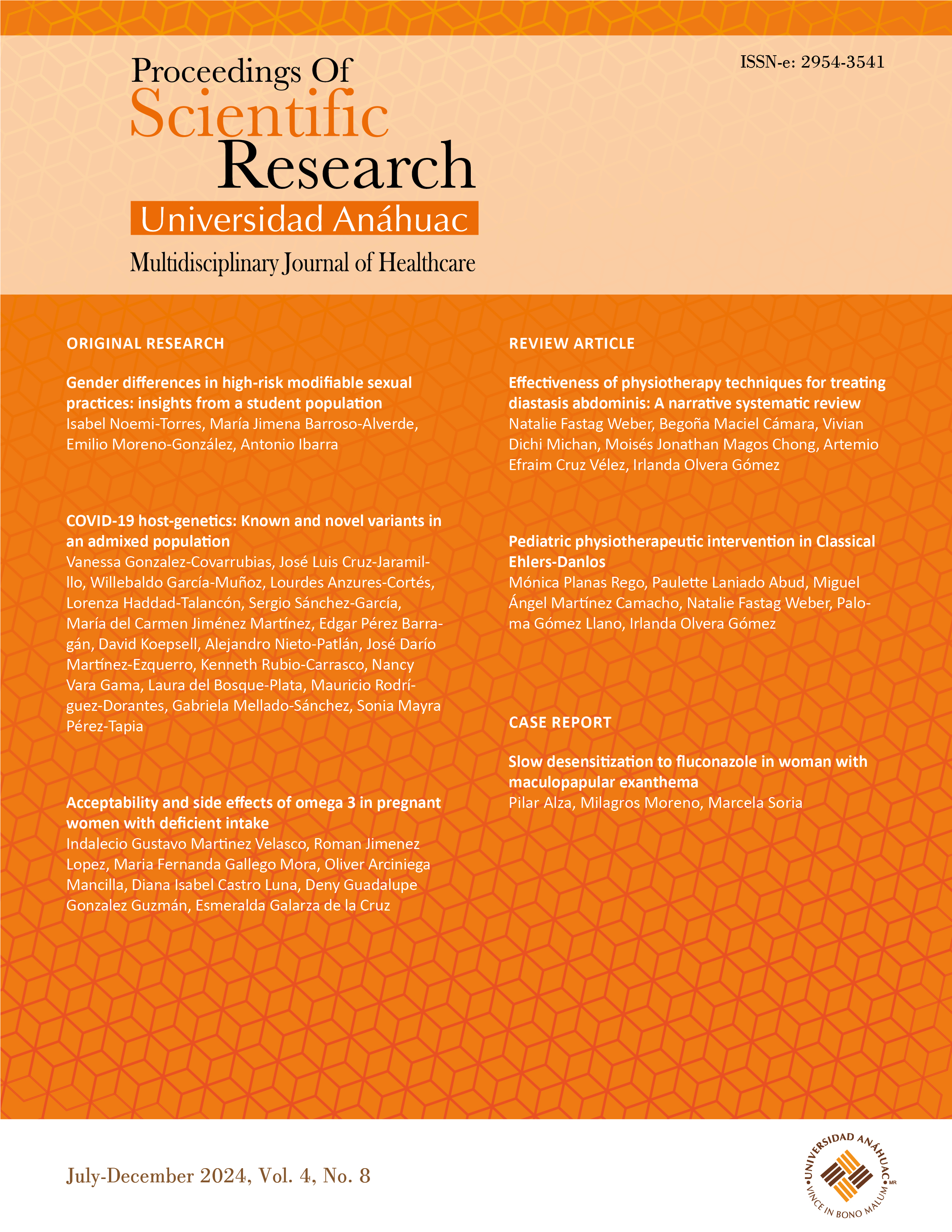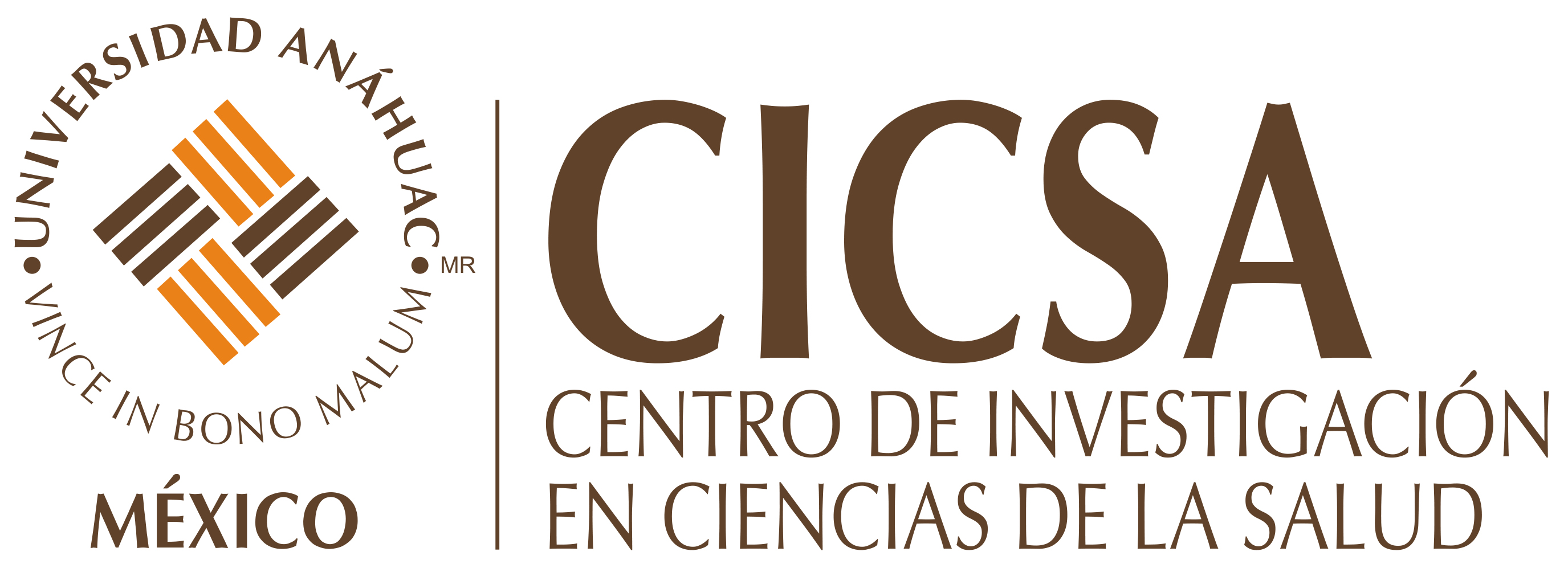Acceptability and side effects of omega 3 in pregnant women with deficient intake
DOI:
https://doi.org/10.36105/psrua.2024v4n8.03Palabras clave:
Parto pretérmino, Omega-3, Pregnancy, Food frequency questionaire, fish, Docosahexanoic acidResumen
Introducción: Los ácidos grasos poliinsaturados n-3, como el EPA y el DHA, son esenciales durante el embarazo por sus beneficios para la salud materna y el desarrollo fetal. En mujeres embarazadas con deficiencia de omega-3, es crucial evaluar la tolerabilidad, aceptabilidad y posibles efectos secundarios para optimizar la adherencia al tratamiento. Objetivo: Determinar la tolerabilidad y los principales efectos colaterales en un grupo de embarazadas con ingesta deficiente de pescado en una comunidad rural. Material y métodos: Se realizó una encuesta nutricional en un grupo de embarazadas que asistían a su control prenatal a una institución privada de Ginecoobstetricia para investigar la necesidad de suplementación con omega-3 mediante un cuestionario simplificado en una población de embarazadas. Se prescribieron 2 cápsulas conteniendo EPA 760 mg y DHA 520 mg a partir de las 20 semanas. Se documentó la presencia de efectos colaterales y la adherencia a la prescripción. Resultados: Se encontró un porcentaje de tolerabilidad del 100.0%. Los efectos colaterales fueron náusea 19.2 %, eructos 4.6 %, aliento a pescado 2.3 %, vómito 1.5 % y ningún caso de reacción alérgica. Ninguna paciente abandonó la suplementación. Conclusiones: Los efectos colaterales de los AGPI n-3 en el presente estudio fueron muy bajos, resultando en una excelente adherencia al tratamiento.
Descargas
Referencias
Calder PC. Very long-chain n-3 acids and human health: fact, fiction, and the future. Proc Nutr Soc. 2018;77:57-72. https://doi.org/10.1017/S0029665117003950
The Lancet [Internet]. Executive Summary of the Lancet Maternal and Child Nutrition Series; c2013. [Cited 2020 Jan 14]. Available at: https://www.thelancet.com/pb/assets/raw/Lancet/stories/series/nutrition-eng.pdf
Danielewicz H, Myszczyszyn G, Debinska A, Myszkal A, Boznanski A, Hirnle L. Diet in Pregnancy—More than food. Eur J Pediatr. 2017;176:1573–1579. https://doi.org/10.1007/s00431-017-3026-5
Gow RV, Hibbeln JR. Omega-3 Fatty Acid and nutrient deficits in adverse neurodevelopment and childhood behaviors. Child Adolesc Psychiatr Clin N Am. 2014;23:555–590. https://doi.org/10.1016/j.chc.2014.02.002
Parra-Cabrera S, Stein AD, Wang M, Martorell R, Rivera, J, Ramakrishnan U. Dietary intakes of polyunsaturated fatty acids among pregnant Mexican women: PUFA intakes of Mexican pregnant women. Matern Child Nutr. 2011;7(2), 140–147. https://doi.org/10.1111/j.1740-8709.2010.00254.x
Shen Y, Zheng L, Jin J, Li X, Fu J, Wang M, et al. Phytochemical and biological characteristics of Mexican Chia seed oil. Molecules. 2018; 23(12), 3219. https://doi.org/10.3390/molecules23123219
Oken E, Musci RJ, Westlake M, Gachigi K et al. Demographic and health characteristics associated with fish and n-3 fatty acid supplement intake during pregnancy: results from pregnancy cohorts in the ECHO programme. Public Health Nutrition. 2024;27(1):e94. https://doi.org/10.1017/S136898002400051X
Al-Hinai M, Baylin A, Tellez-Rojo MM, Cantoral A, Ettinger A, Solano M, et al. Maternal intake of omega-3 and omega-6 polyunsaturated fatty acids during mid-pregnancy is inversely associated with linear growth. J Dev Orig Health Dis. 2018;9(4):432-441. https://doi.org/10.1017/S2040174418000193
Swanson D, Block R, Mousa SA. Omega-3 fatty acids EPA and DHA: Health benefits throughout life. Adv Nutr. 2012;3:1-7. https://doi.org/10.3945/an.111.000893
Burdge GC, Wootton SA. Conversion of Alpha-linolenic acid to eicosapentanoic, docosapentanoic and docosahexanoic acids in Young women. Br J Nutr. 2002; 88:411-420. https://doi.org/10.1079/bjn2002689
Cai F, Young BK, Mccoy A. Commercially available prenatal vitamins do not meet American College of Obstetricians and Gynecologists nutritional guidelines. Am J Perinatol. 2023 Jul 7;41(Suppl 1):e2547–e2554. https://doi.org/10.1055/a-2125-1148
Freeman MP, Shinja P. Tolerability of omega-3 fatty acid supplements in perinatal women. Prostaglandins, Leukotriens and essential fatty acids 2007;77: 203-208. https://doi.org/10.1016/j.plefa.2007.09.004
Middleton P, Gomersall JC, Gould JF, Shepherd E, Olsen S, Makrides M. Omega-3 fatty acid addition during pregnancy. Cochrane Database Syst Rev. 2018; 11(11): CD003402. https://doi.org/10.1002/14651858.CD003402.pub3
US Department of Agriculture & US Department of Health and Human Services [Internet]. Dietary Guidelines for Americans, 2020-2025; c2020 [Cited 2024 July]. Available at: https://dietaryguidelines.gov/resources/2020-2025-dietary-guidelines-online-materials
Thompson M, Hein N, Hanson C, Smith L. Anderson A, Ritcher C, et al. Omega-3 fatty acid intake by age, gender, and pregnancy status in the United States: national health and nutrition examination survey 2003–2014. Nutrients. 2019; 15;11(1):177 https://doi.org/10.3390/nu11010177
Al-Hinai M, Baylin A, Tellez-Rojo MM, Cantoral A, Ettinger A, Solano M, et al. Maternal intake of omega-3 and omega-6 polyunsaturated fatty acids during mid-pregnancy is inversely associated with linear growth. J Dev Orig Health Dis. 2018;9(4):432-441. https://doi.org/10.1017/S2040174418000193
Perez-Rodrigo C, Aranceta J, Salvador G, Varela-Moreiras G. Food Frequency Questionnaires. Nutr Hosp. 2015;31 (Suppl 3):49-56. https://doi.org/10.3305/nh.2015.31.sup3.8751
Cade J, Thompson R,Burley V, Warm D. Development, validation and utilisation of food questionnaires -a review. Public Health Nutr. 2002;5(4):567-87. https://doi.org/10.1079/PHN2001318
Parker G, McClure G, Hegarty BD, Smith IG. The validity of a food frequency questionnaire as a measure of PUFA status in pregnancy. BMC Pregnancy Childbirth. 2015;15:60. https://doi.org/10.1186/s12884-015-0494-3
Parra MS, Schnaas L, Meydani M, Perroni E, Martínez S, Romieu I. Erythrocyte cell membrane phospholipid levels compared against reported dietary intakes of polyunsaturated fatty acids in pregnant Mexican women. Public Health Nutr. 2002; 5(6A):931–7. https://doi.org/10.1079/PHN2002381
Olsen SF, Hansen HS, Sandstróm B, Jensen B. Erythrocyte levels compared with reported dietary intake of marine n-3 fatty acids in pregnant women. Br J Nutr. 1995;73:387-95. https://doi.org/10.1079/BJN19950041
Herter-Aeberli I, Graf C, Vollenweider A, et al. Validation of a food frequency questionnaire to assess n-3 polyunsaturated fatty acids intake in Switzerland. Nutrients. 2019;11(8):1863. https://doi.org/10.3390/nu11081863
Zhou YB, Li HT, Trasande L, Wang L, Zhang Y, Bai M, et al. A correlation study of DHA intake estimated by an FFQ and concentrations in plasma and erythrocytes in mid-and late pregnancy. Nutrients. 2017;9:1256. https://doi.org/10.3390/nu9111256
Kobayashi M, Jwa SC, Ogawa K, Morisaki N, Fujiwara T. Validity of a food frequency questionnaire to estimate long-chain polyunsaturated fatty acid intake among Japanese women in early and late pregnancy. J Epidemiol. 2017;27(1):30–5. https://doi.org/10.1016/j.je.2016.07.001
Crawford SA, Christifano DN, Kerlinga EH, Gajewski BJ, Valentine CJ, Gustafson KM, et al. Validation of an Abbreviated Food Frequency Questionnaire for Estimating DHA Intake of Pregnant Women in the United States. Prostaglandins Leukot Essent Fatty Acids. 2022; 177:102398. https://doi.org/10.1016/j.plefa.2022.102398
Christifano DN, Crawford SA, Lee G, Gajewski BJ, Carlson SE. Utility of a 7- 7-question online screener for DHA intake. Prostaglandins Leukot Essent Fatty Acids. 2022 177:102399. https://doi.org/10.1016/j.plefa.2022.102399
National Institute for Health and Care Excellence (NICE) [Internet]. Omega-3-acid ethyl esters London: British National Formulary (BNF); c2025 [cited 2025 Feb 1]. Available at: https://bnf.nice.org.uk/drug/omega-3-acid-ethyl-esters.html.
Elgar K. EPA/DHA: A Review of Clinical Use and Efficacy. Nutr. Med J. 2022; 1(2): 97-132.
Cheng-Ho C. Safety and tolerability of prescription omega-3 fatty acids: A systematic review and meta-analysis of randomized controlled trials. Prostaglandins Leukot Essent Fatty Acids. 2018; 129:1-12. https://doi.org/10.1016/j.plefa.2018.01.001
Rasmussen K, Catalano PM, Yaktine AL. New guidelines for weight gain during pregnancy: what obstetrician/ gynecologists should know. Current Opin Obstet Gynecol 2009;21(6):521-26. https://doi.org/10.1097/GCO.0b013e328332d24e
The American College of Obstetrics and Gynecology [Internet]. Nutrition during pregnancy: Frequently Asked Question; c2022 [Cited 2024 Jan 5]. Available at: https:// www.acog.org/womens-health/faqs/nutritionduring-pregnancy
Australian Government Department of Health and Aged Care [Internet]. Pregnancy care guidelines; c2020. [Cited 2024 Jan 5] Available at: https://www.health.gov.au/resources/pregnancy-care-guidelines

Descargas
Publicado
Número
Sección
Licencia
Derechos de autor 2024 Indalecio Gustavo Martinez Velasco, Roman Jimenez Lopez, Maria Fernanda Gallego Mora, Oliver Arciniega Mancilla, Diana Isabel Castro Luna, Deny Guadalupe Gonzalez Guzmán, Esmeralda Galarza de la Cruz

Esta obra está bajo una licencia internacional Creative Commons Atribución-NoComercial-SinDerivadas 4.0.
Todo el contenido intelectual que se encuentra en la presente publicación periódica se licencia al público consumidor bajo la figura de Creative Commons©, salvo que el autor de dicho contenido hubiere pactado en contrario o limitado dicha facultad a “Proceedings of Scientific Research Universidad Anáhuac. Multidisciplinary Journal of Healthcare©” o “Universidad Anáhuac México©” por escrito y expresamente.
Proceedings of Scientific Research Universidad Anáhuac. Multidisciplinary Journal of Healthcare se distribuye bajo una Licencia Creative Commons Reconocimiento-No comercial-Sin derivados 4.0 Internacional (CC BY-NC-ND 4.0).
El autor conserva los derechos patrimoniales sin restricciones y garantiza a la revista el derecho de ser la primera publicación del trabajo. El autor es libre de publicar en cualquier otro medio su artículo, como un repositorio institucional.














